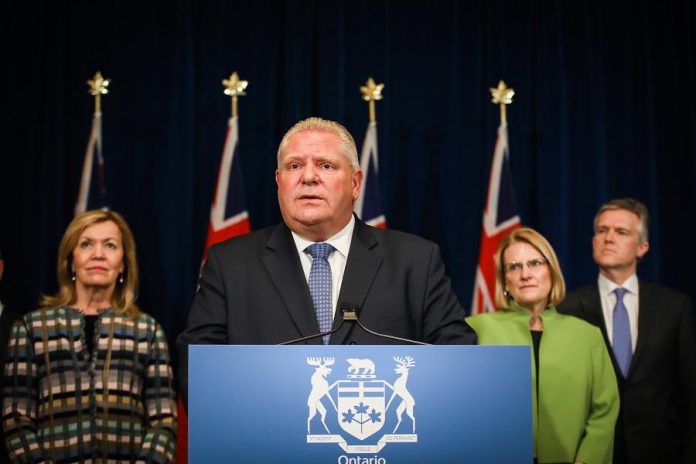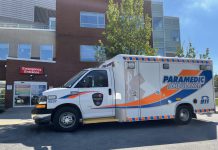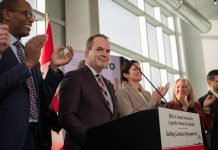
Ontario Premier Doug Ford has declared a state of emergency in the province to fight the spread of COVID-19.
Ford made the announcement at an 8:30 a.m. media conference on Tuesday (March 17) at Queen’s Park, along with Ontario Solicitor General Sylvia Jones, Health Minister Christine Elliott, and Finance Minister Rod Phillips.
As part of the emergency order, Ford said Ontario is immediately prohibiting gatherings of more than 50 people, including parades, events, and communal services within places of worship.
Also effective immediately, Ontario is ordering the closure of all indoor recreational programs, libraries, private schools, licensed child care, bars and restaurants (except those that can provide take-out and delivery), all theatres (including those offering live performances of music, dance, and other art forms), cinemas that show movies, and concert venues.
Malls and retail stores are not currently included in the order.
The emergency measures are in effect until Tuesday, March 31st.
“This is not a provincial shutdown; I repeat, this is not a provincial shutdown,” Ford said. “The vast majority of businesses, including those most vital to day-to-day life, will not be affected by this order.”
Ford said that essential services, grocery stores, convenience stores, drug stores, manufacturing facilities, public transit, and office buildings would continue to operate.
Ford added the measures are necessary to avoid overwhelming the health care system.
“We must think about our children, our parents, our grandparents,” Ford said. “We must think about our neighbours, our colleagues, and our friends … It is imperative we protect every person and every family across this province. We must act decisively, we must not delay.”
“This decision was not made lightly,” Ford said, adding that the decision was made after consultation with public health officials and after a meeting of cabinet. “We are taking these measures now while our system is strong.”
Ford made efforts during his remarks to discourage fear and panic, particularly when it comes to financial impact.
“I want to urge calm across the province,” Ford said. “No expense will be spared to support Ontarians in need. There is no measure we will not consider. We must flatten the curve and stop the spread of COVID-19.”
Ford announced the first stage of a COVID-19 emergency relief package, which includes $300 million. Part of a larger package, the $300 million will be used for immediate measures, including protecting seniors and those most vulnerable to the effects of COVID-19.
Immediate measures include funding for 75 critical-care beds and 500 post-acute care beds 25 more COVID-19 assessment centres, more testing resources and protective equipment for frontline workers, more ventilators, 24/7 screening support for long term care homes as well as infection control and cleaning supplies, backfilling 1,000 nurses and personal support workers at hospitals, and funding for 50 physicians to provide primary and emergency care in indigenous, rural, and remote communities.
Ford also said the federal government must work with Ontario to establish a loan program to support business, as well as immediate Employment Insurance reforms to support workers affected by COVID-19.
“We will spare no expense to support Ontarians,” Ford said. “We must come together as a province. Every Ontarian must support each other … Ontario will come out of this stronger than ever before.”
The legislation that gives the Ontario government the power to declare a state of emergency is the Emergency Management and Civil Protection Act, which gives the province the authority to close “any place, whether public or private, including any business, office, school, hospital or other establishment or institution.”
Breakdown of $304 million in funding for first phase of COVID-19 emergency relief
- $100 million for increased capacity in hospitals to assist with the effective treatment of COVID-19 patients both in critical care and medicine beds.
- $50 million for more testing and screening through public health, including additional funding to support extraordinary costs incurred to monitor, detect and contain COVID-19 in the province. This includes contact tracing, increased laboratory testing capacity and home testing.
- $50 million to further protect frontline workers, first responders and patients by increasing the supply of personal protective equipment and other critical supplies and equipment to protect them.
- $25 million to support frontline workers working in COVID-19 assessment centres, including the creation of a new fund to provide respite care, child care services and other supports as they are needed.
- $50 million for long-term care homes to support 24/7 screening, additional staffing to support infection control and additional supplies.
- $20 million for residential facilities in developmental services, gender-based services and protective care for children and youth to support additional staffing, respite for caregivers impacted by school closures, personal protective equipment and supplies and transportation costs to minimize client exposure and to support social distancing, as well as additional cleaning costs.
- $5 million to protect seniors in retirement homes through increased infection control and active screening procedures.
- $4 million for indigenous communities to support transportation costs for health care professionals and the distribution of critical supplies.


























